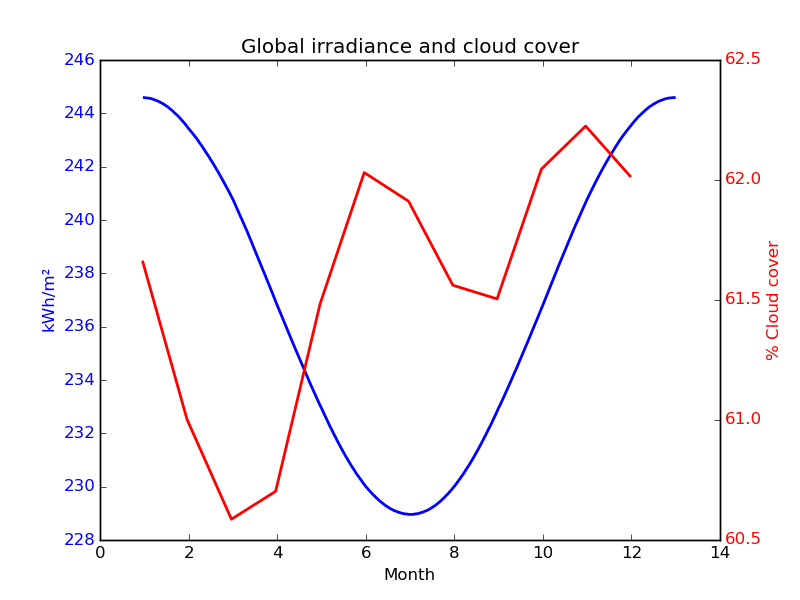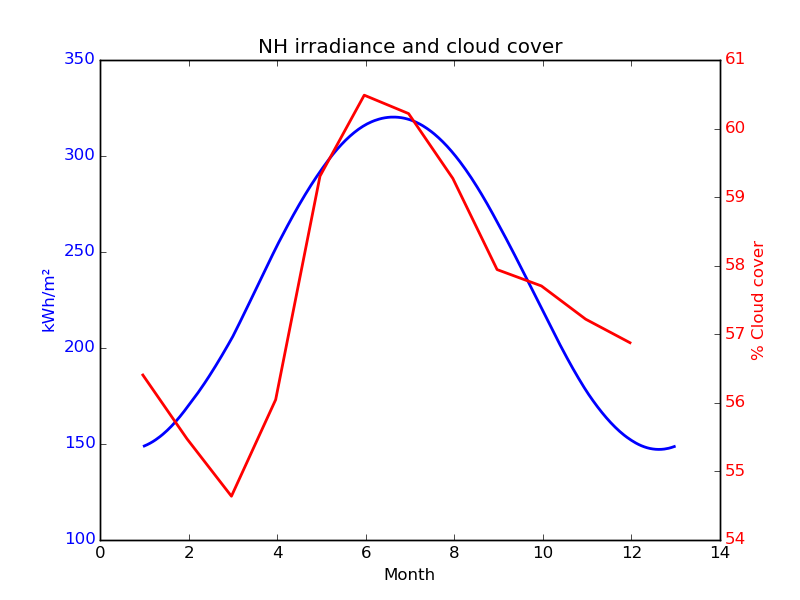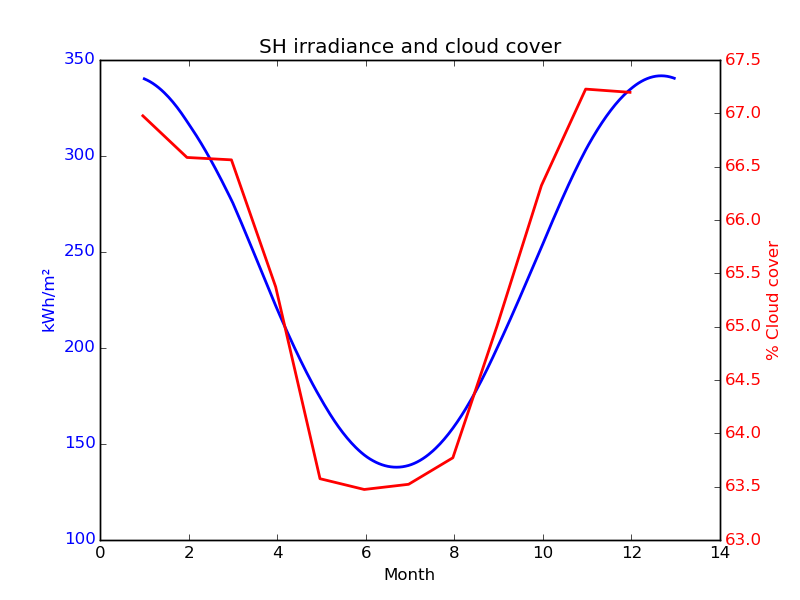The Cloud feedback
In the comments to my last post, led the signature "Slabadang" me on an interesting track. He claimed that the clouds varied in tune with the solar radiation. If this would be the clouds would have a negative feedback and thus balance the climate. I downloaded the satellite data from CERES to check his data.
Below is how the global cloud cover varies with the global solar radiation. The reason that solar radiation varies over the year is that the Earth is in an elliptical orbit around the sun. When we in the northern hemisphere has winter, we are therefore closest to the sun. However, it is the angle to the sun which means we have winter.

The global cloud cover and solar radiation variation over the year. The cloud cover is an average of the years 2000 to 2014.
So it is a poor correlation between cloud cover and solar radiation if you look at the Earth as a whole. However piling a completely different picture up if you instead look at the two hemispheres:
For the two hemispheres, there is thus a very good correlation between solar radiation and cloud cover. The reason that you can not see any correlation globally is likely that these variations are so much less that they drown out the noise of the large variations in the hemispheres.
It is thus clear that cloud cover increases when solar radiation increases. Then the sun's rays do not reach the earth's surface and then counteracts the clouds changes. The same must therefore apply to the carbon dioxide effect. When it increases, the clouds that counteract the temperature change. Here we have again an example that there is a negative feedback and not a positive feedback that the whole scare propaganda in climate science based.
Note also that the clouds are much larger in the southern hemisphere than it is in the northern hemisphere. The reason for this is that there are more clouds over the oceans, and there's a lot more sea in the southern hemisphere.
Climate sensitivity
It is thus more clouds in the southern hemisphere, and the temperature is also lower. Looking at 1000hPa level (near surface), the average temperature of the southern hemisphere 14.4C and for the northern hemisphere 16.5C. After millions of years of energy storage in the oceans of the southern hemisphere, then the temperature is still much lower. One can not interpret it otherwise than that the oceans hold temperature. A major reason for this must be that the clouds in the southern hemisphere allows the sun's rays do not reach the earth's surface.
In the southern hemisphere, the average cloud cover 65.5% and in the northern hemisphere 57.6%, according to CERES-date. If the average solar radiation is 237W / m2 can then southern hemisphere approximately 7.9% of 237W / m2 = 18.7W / m2 less sun than the Northern Hemisphere. Now this is probably a little high counted for even if the cloud cover is 100%, the clouds themselves to radiate towards the Earth's surface.
The difference in temperature between the southern and northern hemisphere is thus 2.1c and the difference in solar is about 18.7W / m2. It allows every Watt / m2, equivalent to about 0.11 degree. A doubling of carbon dioxide levels will provide approximately 3.7W / m2, it therefore corresponds to approximately 0.4 degrees (climate sensitivity). Now I have probably figured a little low, since the change in insolation probably figured a little high, and there may also be other reasons that the temperature between the hemispheres differ. But it is still very far from the many degrees of climate sensitivity horror forecasts suggest. I have previously calculated the climate sensitivity of about 0.3 degrees by looking at seasonal variations (here).


A very nice piece of work. Well done. Very smart to look at each hemisphere separately,
ReplyDeleteThanks for translating my blog post to english. It should be noted that the climate sensitivity calculation using the difference between the hemispheres is speculative and should just be used as a basis for a discussion.
ReplyDeleteAnother great post. Most illuminating. Thanks.
ReplyDelete~ Mark
This has nothing to do with Svensmark's cosmic ray hypothesis, but simply shows that there are more clouds during the summer.
ReplyDeleteYou're correct, I have changed the title to the post accordingly.
DeleteI think the title is still not correct, as there is no feedback involved [the clouds do not react back on what the sun puts out[. The reason for the correlation is simply that more solar radiation evaporates more water, hence more clouds.
DeleteThe clouds are indeed a negative feedback: More solar insolation causes more evapotranspiration, which increases clouds, which then self-regulates by decreasing insolation.
DeleteIt looks like what you plot is the variation of solar irradiance [not insolation] due to the variation of distance to the Sun and Seasonal Change of Zenith Angle, thus no feedback.
ReplyDelete